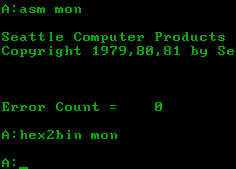A disk operating system is a computer operating system that resides on and can use a disk storage device, such as a floppy disk, hard disk drive, or optical disc. A disk operating system must provide a file system for organizing, reading, and writing files on the storage disk. Strictly speaking, this definition does not include any other functionality, it doesn't apply to more complex OSes, such as current generations of PC operating systems like the versions of Microsoft Windows in use, and is more appropriately used only for older generations of operating systems.

Gary Arlen Kildall was an American computer scientist and microcomputer entrepreneur.

CP/M, originally standing for Control Program/Monitor and later Control Program for Microcomputers, is a mass-market operating system created in 1974 for Intel 8080/85-based microcomputers by Gary Kildall of Digital Research, Inc. Initially confined to single-tasking on 8-bit processors and no more than 64 kilobytes of memory, later versions of CP/M added multi-user variations and were migrated to 16-bit processors.
A RAM drive is a block of random-access memory that a computer's software is treating as if the memory were a disk drive. It is sometimes referred to as a virtual RAM drive or software RAM drive to distinguish it from a hardware RAM drive that uses separate hardware containing RAM, which is a type of battery-backed solid-state drive.

In computer data storage, drive letter assignment is the process of assigning alphabetical identifiers to volumes. Unlike the concept of UNIX mount points, where volumes are named and located arbitrarily in a single hierarchical namespace, drive letter assignment allows multiple highest-level namespaces. Drive letter assignment is thus a process of using letters to name the roots of the "forest" representing the file system; each volume holds an independent "tree".

Digital Research, Inc. was a company created by Gary Kildall to market and develop his CP/M operating system and related 8-bit, 16-bit and 32-bit systems like MP/M, Concurrent DOS, FlexOS, Multiuser DOS, DOS Plus, DR DOS and GEM. It was the first large software company in the microcomputer world. Digital Research was originally based in Pacific Grove, California, later in Monterey, California.
MP/M is a discontinued multi-user version of the CP/M operating system, created by Digital Research developer Tom Rolander in 1979. It allowed multiple users to connect to a single computer, each using a separate terminal.

CP/M-86 was a version of the CP/M operating system that Digital Research (DR) made for the Intel 8086 and Intel 8088. The system commands are the same as in CP/M-80. Executable files used the relocatable .CMD file format. Digital Research also produced a multi-user multitasking operating system compatible with CP/M-86, MP/M-86, which later evolved into Concurrent CP/M-86. When an emulator was added to provide PC DOS compatibility, the system was renamed Concurrent DOS, which later became Multiuser DOS, of which REAL/32 is the latest incarnation. The FlexOS, DOS Plus, and DR DOS families of operating systems started as derivations of Concurrent DOS as well.

86-DOS is a discontinued operating system developed and marketed by Seattle Computer Products (SCP) for its Intel 8086-based computer kit.

Seattle Computer Products (SCP) was a Tukwila, Washington, microcomputer hardware company which was one of the first manufacturers of computer systems based on the 16-bit Intel 8086 processor. SCP began shipping its first S-100 bus 8086 CPU boards to customers in November 1979, about 21 months before IBM introduced its Personal Computer which was based on the slower 8088 and introduced the 8-bit ISA bus. SCP shipped an operating system for that hardware about a year before the release of the PC, which was modified by Microsoft for the PC and renamed IBM PC DOS. SCP was staffed partly by high-school students from nearby communities who soldered and assembled the computers. Some of them would later work for Microsoft.

Multiuser DOS is a real-time multi-user multi-tasking operating system for IBM PC-compatible microcomputers.
A source-to-source translator, source-to-source compiler, transcompiler, or transpiler is a type of translator that takes the source code of a program written in a programming language as its input and produces an equivalent source code in the same or a different programming language. A source-to-source translator converts between programming languages that operate at approximately the same level of abstraction, while a traditional compiler translates from a higher level programming language to a lower level programming language. For example, a source-to-source translator may perform a translation of a program from Python to JavaScript, while a traditional compiler translates from a language like C to assembler or Java to bytecode. An automatic parallelizing compiler will frequently take in a high level language program as an input and then transform the code and annotate it with parallel code annotations or language constructs.
A self-booting disk is a floppy disk for home or personal computers that loads directly into a standalone application when the system is turned on, bypassing the operating system. This was common, even standard, on some computers in the late 1970s to early 1990s. Video games were the type of application most commonly distributed using this technique.
Microcosm Ltd is a UK company established in 1979. Its early claims to fame included Silicon Disk System in 1981 and Microcache in 1982.
This article presents a timeline of events in the history of 16-bit x86 DOS-family disk operating systems from 1980 to present. Non-x86 operating systems named "DOS" are not part of the scope of this timeline.

MS-DOS is an operating system for x86-based personal computers mostly developed by Microsoft. Collectively, MS-DOS, its rebranding as IBM PC DOS, and a few operating systems attempting to be compatible with MS-DOS, are sometimes referred to as "DOS". MS-DOS was the main operating system for IBM PC compatibles during the 1980s, from which point it was gradually superseded by operating systems offering a graphical user interface (GUI), in various generations of the graphical Microsoft Windows operating system.

DOS is a platform-independent acronym for "disk operating system" that later became a common shorthand for disk-based operating systems on IBM PC compatibles. DOS primarily consists of Microsoft's MS-DOS and a rebranded version under the name IBM PC DOS, both of which were introduced in 1981. Later compatible systems from other manufacturers include DR DOS (1988), ROM-DOS (1989), PTS-DOS (1993), and FreeDOS (1998). MS-DOS dominated the IBM PC compatible market between 1981 and 1995.









